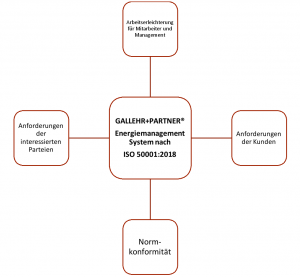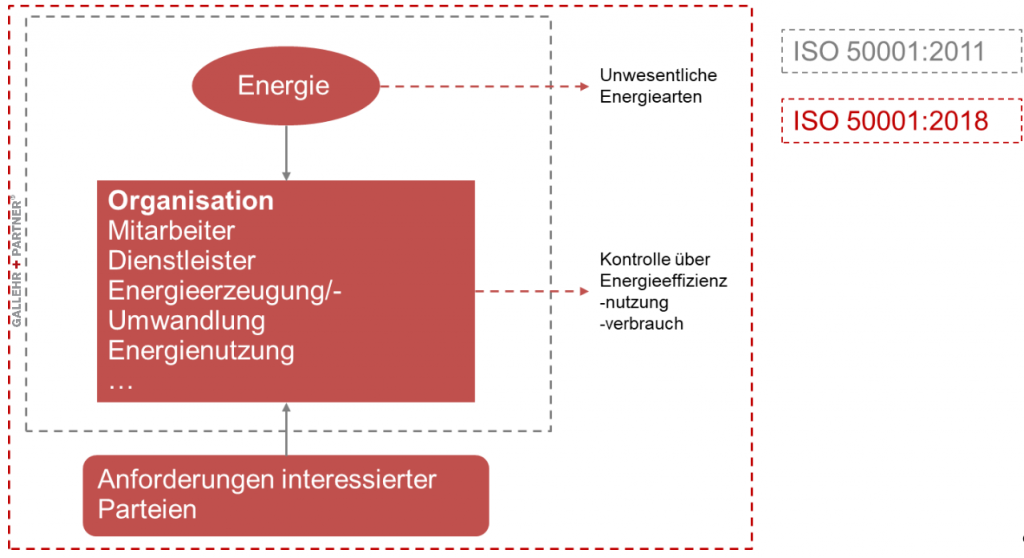In the previous posts on this practice note, we have provided a general
Overview of the energy management standard ISO 50001
and the specific
Challenges of implementing an energy management system according to ISO 50001:2018
given. In this paper we address the important issue of the context in which an energy management system should be operated. Only if the context of the energy management system is correctly understood in relation to the organization or the company in which it is to be effective, can the management system also unfold its potential for cost savings, energy savings and CO2 neutrality.
It is not only the standard that requires a good understanding of the context in which the organisation wishes to implement a management system at the outset. Right after clarifying the terms, ISO 50001:2018 states:
“4.1 Understanding the organization and its context
The organization shall identify external and internal issues that are relevant to its purpose and impact its ability to achieve the intended outcome(s) of its EnMS and improve its energy-related performance.”
GALLEHR+PARTNER® also recommends that in order to establish an effective management system, a good understanding of the overall context in which this system is to operate should be developed right at the beginning.

At the start of the project, we held an initial target workshop with the customer accordingly. Moderated by GALLEHR+PARTNER®, the first step was to define the requirements and the scope of the energy management system beyond the compatibility of the standards.
Define scope of application
In ISO 50003, the sub-standard that specifies the requirements for bodies auditing or certifying energy management systems, the definition of the scope of application is of particular importance. Under 5.2 it states:
“5.2 Confirmation of the scope of certification:
The organization shall define the scope and boundaries of the EnMS, however, the certification body shall confirm the adequacy of the scope and boundaries at each audit.”
The scope requirements have expanded in ISO 50001:2018 compared to the previous revision of the standard:
GALLEHR+PARTNER® Practical Tip:
In order to be aware of changes on a regular basis, we recommend to describe and, if necessary, update the scope of application within the annual energy assessment.
The new aspect of control over energy efficiency in particular can only be taken into account if it is jointly reflected in conjunction with the requirements of the interested parties.
Interested parties
The standard requirement “Understanding the needs and expectations of interested parties” is familiar to many companies in the environmental management sector. ISO 140001:2015 also calls for a similar understanding here.
If there is corresponding documentation in the environmental management system, it should be reflected on again from the energy point of view and supplemented if necessary. However, if companies do not have any corresponding documented findings, GALLEHR+PARTNER® recommends the development of a matrix for documentation.
In addition to naming the party and describing how the party relates to the organization, the matrix should describe two other levels. On the one hand, the risks and opportunities of all aspects should be reflected here immediately and, on the other hand, the resulting relevance assessment.
The relevance rating of the interested parties enables the energy manager to prioritize the parties in the following. He can then use this to focus on the most relevant lots when communicating. It should be done separately in two directions. On the one hand, the party often has an impact on improving energy-related performance. On the other hand, the energy management system often has an impact on the interested party.
These two influencing factors can differ greatly, which is why GALLEHR+PARTNER® recommends evaluating them individually in order to be able to make an independent prioritization.
GALLEHR+PARTNER® Practical Tip:
For each party, measures can also be defined in the course of creating the matrix, which have the potential to reduce the identified risks and develop the opportunities.
Roles and responsibilities
ISO 50001:2018, requires in chapter 5.3:
“5.3 Roles, responsibilities and authorities in the organization:
“Top management must ensure that responsibilities and authorities for relevant roles are assigned and communicated within the organization.”
It is advisable to develop an initial understanding of future roles and responsibilities at this early stage of setting up an energy management system. For a structured approach to this, a matrix should again be developed here. The responsibility matrix, which can then be part of the guided energy management description in the following, or can also be further maintained independently as a guided document, also additionally fulfils the requirement according to ISO 50001:2018 Chapter 7.4 Communication:
The organization shall determine internal and external communications related to the EnMS, including: (a) what is communicated about; (b) when to communicate; (c) with whom communication takes place; (d) how to communicate; (e) who communicates.”
Define energy-relevant processes
All activities carried out within the scope under consideration (system boundary) should be divided into energy-relevant processes. The processes and the delimitation to each other are then described and updated in each case. Based on the energy-relevant processes, the energy performance indicators (EnPi) and the significant energy users (SEU) are then defined.
GALLEHR+PARTNER® Practical Tip:
Even though it is often difficult, we recommend defining a maximum of 5 energy-relevant processes. If more processes were to be defined, the energy evaluation would lose much of its clarity.
Determine the period under consideration
ISO 50001 requires that past and current energy use and consumption be assessed. As a rule, the annual energy input is taken as the appropriate period. This then forms the initial energy basis for the energy management system. However, care must be taken to ensure that the valuation is possible with a comparable earlier period.
However, if the energy management system is introduced at a time when there is no energy use yet, or if the system is in the start-up phase, a defined planning status can also be used for the initial energy assessment. In this case, however, a detailed description and documentation of the planning status is required so that the following energetic evaluation, which must then already be carried out with real energy flows, can be compared with this theoretical energetic starting basis.


